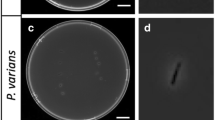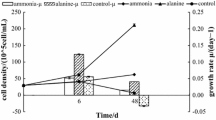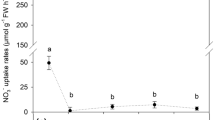Abstract
Reciprocal inhibition experiments concerning the simultaneous absorption of acidic, basic and neutral amino acids give evidence that Anemonia sulcata Pennant (Coelenterata: Anthozoa) possess at least three distinct uptake systems for amino acids. The absorption of amino acids belonging to the same class is mutually inhibited. Increasing inhibitor concentrations reduce the uptake of the substrate successively, indicating that the receptors are saturated only at high substrate concentrations; this is not the case under natural conditions. The uptake system for acidic amino acids is highly specific; uptake is not inhibited by either basic or neutral amino acids. The specificity for basic amino acids is lower; uptake is influenced by neutral amino acids. Neutral amino acids are absorbed either by one single system with broad specificity or by several systems with overlapping specificity. D- and L-isomers seem to be absorbed by the same system, as the uptake is reciprocally inhibited. The restricted specificity of the amino-acid uptake systems, especially those for neutral amino acids, could be explained as an adaptation to avoid accumulation of certain amino acids in a most economic way. Moreover, a broad spectrum of various dissolved organic materials can thus be utilized. The experiments also give evidence that anemones are able to supply their metabolism completely with the necessary substances by absorbing dissolved organic material. The absorbed substances may, furthermore, be vital for the metabolism, although their individual energy content may be negligible. Anemones display optimum fitness to an important environmental factor-dissolved organic material — on a macromolecular level, in addition to structural and physiological adaptations.
Similar content being viewed by others
Literature Cited
Bamford, D.R. and R. McCrea: Active absorption of neutral and basic amino acids by the gill of the common cockle, Cerastoderma edule. Comp. Biochem. Physiol. 50A, 811–817 (1975)
— and M. Stewart: Absorption of neutral amino acids by the gut of Arenicola marina. J. comp. Physiol. 82, 291–304 (1973a)
——: Absorption of charged amino acids by the intestine of Arenicola marina. Comp. Biochem. Physiol. 32A, 537–547 (1973b)
Bohling, H.: Gelöste Aminosäuren in Oberflächenwasser der Nordsee bei Helgoland: Konzentrationsveränderungen im Sommer 1970. Mar. Biol. 16, 281–289 (1972)
Jørgensen, C.B.: August Pütter, August Krogh, and modern ideas on the use of dissolved organic matter in aquatic environments. Biol. Rev. 51, 291–328 (1976)
Pandian, T.J.: Mechanisms of heterotrophy. In: Marine ecology. Vol. II. Physiological mechanisms, Part 1. pp 61–249. Ed. by O. Kinne. London: Wiley Interscience 1975
Pappas, P.W. and C.P. Read: Parasitological review: membrane transport in helminth parasites. Expl Parasit. 37, 469–530 (1975)
Riley, J.P. and R. Chester: Introduction to marine chemistry, 465 pp. London & New York: Academic Press 1971
Robinson, J.W.L.: Comment to lecture of G. Semenza. In: Biochemical and clinical aspects of peptide and amino acid absorption, pp 59–60. Ed. by K. Rommel and H. Goebell Stuttgart-New York: Schattauer 1973
Schlichter, D.: Aktinien nehmen Aminosäuren und Glucose aus dem Meerwasser auf. Naturwissenschaften 58, 455–456 (1971)
—: Ernährungsphysiologische und ökologische Aspekte der Aufnahme in Meerwasser gelöster Aminosäuren durch Anemonia sulcata (Coelenterata, Anthozoa). J Oecologia (Berl.) 11, 315–350 (1973)
—: Der Einfluß physikalischer und chemischer Faktoren auf die Aufnahme in Meerwasser gelöster Aminosäuren durch Aktinien. Mar. Biol. 25, 279–290 (1974)
—: Die Bedeutung in Meerwasser gelöster Glucose für die Ernährung von Anemonia sulcata (Coelenterata: Anthozoa). Mar. Biol. 29, 283–293 (1975a)
—: The importance of dissolved organic compounds in sea water for the nutrition of Anemonia sulcata Pennant (Coelenterata). Proc. Eur. mar. biol. Symp. 9, 395–405 (1975b)
Sepers, H.B.J.: The utilization of dissolved organic compounds in aquatic environments. Hydrobiologia 52, 39–54 (1977)
Siebers, D.: Absorption of neutral and basic amino acids across the body surface of two annelid species. Helgoländer wiss. Meeresunters. 28, 456–466 (1976)
Stephens, G.C.: Dissolved organic matter as a potential source of nutrition for marine organisms. Am. Zool. 8, 95–106 (1968)
—: Amino acid accumulation and assimilation in marine organisms. In: Nitrogen metabolism and the environment, 318 pp. Ed. by J.W. Campbell and L. Goldstein. London: Academic Press 1972
Taylor, A.G.: The direct uptake of amino acids and other small molecules from seawater by Nereis virens. Comp. Biochem. Physiol. 29, 243–250 (1969)
Tiffon, Y.: Hydrolases dans l'ectoderme de Cerianthus lloydi Gosse, Cerianthus membranaceus Spallanzani et Metridium senile (L): mis en évidence d'une digestion extracellulaire et extracorporelle. J. exp. mar. Biol. Ecol. 18, 243–254 (1975)
Trench, R.K.: Nutritional potential in Zoanthus sociathus (Coelenterata, Anthozoa). Helgoländer wiss. Meeresunters. 26, 174–216 (1974)
Van Pilsum, J.F., D. Taylor and L. Bans: Studies on the uptake of creatine from sea water by the marine annelid, Glycera dibranchiata. Comp. Biochem. Physiol. 51A, 611–617 (1975)
Wagner, F.S., Jr.: Composition of the dissolved organic compounds in sea water: a review. Contr. mar. Sci. Univ. Tex. 14, 115–153 (1969)
Author information
Authors and Affiliations
Additional information
Communicated by O. Kinne, Hamburg
Rights and permissions
About this article
Cite this article
Schlichter, D. On the ability of Anemonia sulcata (Coelenterata: Anthozoa) to absorb charged and neutral amino acids simultaneously. Mar. Biol. 45, 97–104 (1978). https://doi.org/10.1007/BF00390545
Accepted:
Published:
Issue Date:
DOI: https://doi.org/10.1007/BF00390545




